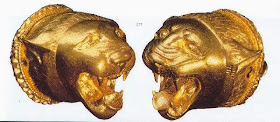Pages
▼
Etruscan Gold Diadem
Etruscan civilization, Gold diadem (crown). From Spina, Ferrara Province, Museo Archeologico Nazionale (Archaeological Museum)
Etruscan Gold: Gold earring, from Cerveteri (Lazio)
Gold earring, from Cerveteri (Lazio). Etruscan civilization, 4th Century BC. Artwork-location: Rome, Museo Nazionale Etrusco Di Villa Giulia (Villa Giulia National Museum, Archaeological Museum)
Etruscan Gold: Carnelian scarab gold ring, from Cerveteri (Lazio),
ITALY : Scarab gold ring, from Cerveteri (Lazio). Etruscan civilization, 4th Century BC. (Photo by DeAgostini/Getty Images)
Etruscan Gold: Gold Hair Clips for Plaits, from Cerveteri, Lazio
Etruscan civilization,7th century b.C. Goldsmithery. Gold hair clips for plaits. From Cerveteri, Lazio Region, Italy. Artwork-location: Rome, Museo Nazionale Etrusco Di Villa Giulia (Villa Giulia National Museum, Archaeological Museum)
Etruscan Gold: Gold and amber necklace, from Cerveteri (Lazio)
The Etruscans were regarded by the ancients as addicted to luxury. If we consider the period from the ninth to the seventh century BC with the tombs " princely " found in Cerveteri , Palestrina ( Praeneste ) , Pontecagnano Vetulonia and we actually believe that the flaunting of wealth was a widespread practice in the rich Etruscan nobility who obviously could not afford a large class employee and as a result a significant economic surplus that was hoarded with objects of personal adornment
Gold and amber necklace, from Cerveteri (Lazio) Etruscan Civilization, 7th Century BC. Artwork-location: Città Del Vaticano, Vatican Museums, Etruscan Museum
Gold and amber necklace, from Cerveteri (Lazio) Etruscan Civilization, 7th Century BC. Artwork-location: Città Del Vaticano, Vatican Museums, Etruscan Museum
Etruscan Gold: Gold Rings, from Cerveteri (Lazio)
Gold ring, from Cerveteri (Lazio). Etruscan civilization, 6th Century BC.
Gold ring, from Cerveteri (Lazio). Etruscan civilization, 5th Century BC
Excavations at Poggio Colla
 |
| Etruscan Gold Diadem |
Poggio Colla is an Etruscan archaeological site located near the town of Vicchio in Tuscany, Italy. Poggio Colla was inhabited by the early 7th century BCE. The settlement was "violently" destroyed in the late 3rd century BCE and rebuilt in the Hellenistic period
The first excavations of Poggio Colla were directed by Francesco Nicosia from 1968 to 1972. Excavations at the site have revealed fortifications, a possible temple, and a necropolis.
 |
| Etruscan Pendants |
Archaeological evidence suggests that Poggio Colla was occupied from as early as 650 B.C.E. until at least 187 B.C.E. The site centers on the acropolis, a roughly rectangular plateau of one and a half acres at the summit of Poggio Colla. Excavations have found strong evidence that the acropolis was a sanctuary and have identified a building and an altar associated with the structure. The building’s form evolved from a modest hut-like structure in the seventh century B.C.E. to a monumental complex with stone foundations and tile roofs by the time of its destruction in the second century B.C.E. [...]
 |
Sheet-gold earrings from the gold cache, dating from the fourth-third centuries B.C. |
 | ||
A gold ring found under an upside-down architectural
block capping an
|
Etruscan Gold Earrings
From the Temple and the Tomb, a collection of 300 funerary and devotional pieces from the Florence Archaeological Museum
Etruscan Gold trumpet-shaped earrings with relief decoration
Gold trumpet-shaped earrings with relief decoration, Etruscan, Classical period, circa 5th-4th century BC Metropolitan Museum

.+From+Spina,+Ferrara+Province.jpg)


.+Etruscan+civilization,+4th+Century+BC..jpg)



.+Etruscan+civilization,+6th+Century+BC..jpg)

.+Etruscan+civilization,+5th+Century+BC.jpg)



